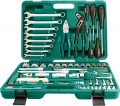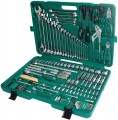Total number of items
The total number of core items included in the set.
In this case, the main items are all devices that are directly used during work: non-separable tools (traditional wrenches, hammers, pliers ...), elements of collapsible tools (for example, a ratchet for removable heads and 5 such heads will be considered 6 units) , as well as accessories (such as extensions or universal joints). Additional accessories — such as lights — may or may not be included in this count, depending on the manufacturer; however, there are usually few such accessories, and they do not fundamentally affect the total number of items.
The most modest modern tool kits include
up to 25 units. However, such kits are very popular — they are inexpensive and at the same time can be very versatile.
25 – 50 items is still quite a small number,
50 – 75 pcs can be called an average,
76 – 100 items are more than average, and the most extensive modern sets can include
100 – 150 items or even
more.
The general rules for choosing this parameter are obvious: a more extensive set, usually, is more multifunctional, but more expensive, weighs more and takes up more space. It is also worth bearing in mind that with a similar number of items, the specific assortment of these items in differ
...ent sets may be different; so when choosing, it is worth specifying not only the number of tools, but also their specific composition.Socket heads (6 points)
Number of
hex sockets included in the tool kit.
All end heads are accessories for a collapsible tool; during operation, they are mounted on a ratchet, wrench or other similar device. The head itself has the appearance of a characteristic “cap”, which, during operation, is put on a bolt, nut, etc. This design, among other things, allows you to work with parts located in recesses and some other hard-to-reach places that cannot be reached with open-ended, captive or split keys. And compared to a set of classic socket wrenches, the holder plus socket set takes up much less space, providing almost the same functionality.
As for the 6 faces, this type of socket head is the most famous and widespread, because. most modern nuts and bolts have this shape.
Bits
The number of
bits supplied with the tool kit.
A bat in this case is called a working nozzle, which plays the role of a screwdriver tip; in fact, they are most often used with screwdriver handles (see above).
Many types of splines (slots) are used in modern fasteners — starting with the well-known
straight, cross-shaped (
Phillips and
Pozidriv),
Torx sprockets and ending with exotics like Torq-set (a cross with lines shifted from the centre), Pentalobe (with five ledges), etc. .P. In addition, the size of the slots can also vary, and in many cases, tool matching in size is very important. Accordingly, the more bits supplied with the set, the more versatile it is, the higher the probability that it will contain a nozzle of the desired type and size. However, the specific list of bits in the kit also does not hurt to clarify — in order to make sure that it has all the varieties you need. In the characteristics of individual sets, these data are given in the paragraph "Bit sizes" (see below).
Adapter
An adapter for docking seemingly incompatible elements from a set. For example, socket heads with an unsuitable landing square on a ratchet, screwdriver handle or in a drill driver.
The adapter provides full-fledged work with all the required list of tools from the set.
Screwdriver handle
Number of
screwdriver handles supplied with the tool kit.
Such handles, in fact, are screwdrivers without a tip — in its place there is a seat for a bit. It can be either a square (see above) or a hexagon socket, often magnetic; in fact, the presence of more than one handle in the kit is typical mainly for cases where different types of fasteners are used. Also note that, in addition to fixed mounts, in which the bit is fixed rigidly, there are also reversible devices — with a ratchet mechanism, similar in operation to ratchets (see above).
Theoretically, bits can be used with other types of tools — for example, the ratchets described above — and in many sets this possibility is directly provided. At the same time, it is work in the format of a screwdriver that is considered the classic option, and often it is he who is optimal.
Tap wrench
The number of knobs supplied with the tool kit.
The collars are a composite tool and are used exclusively in combination with various nozzles, and sometimes with bits. As the name implies, they are designed to rotate such nozzles; moreover, the common point for all the knobs is that the nozzle is located perpendicular to the handle — this provides a large lever arm length and high torque with a relatively small effort on the handle. The specific design of the collars may be different. One of the most popular options is T-shaped devices, which can also vary: the nozzle mount can be located in the centre of the handle or closer to one of the edges, it can be movable or fixed, removable or non-removable, etc. There are also L-shaped collars, similar to socket wrenches (see above) with interchangeable nozzles; cardan, in which the mount is located at the very end and can be rotated to a selected angle, etc. If there are several wrenches in the kit, they usually have the same design, and the main differences are in the length of the handles, as well as the types and sizes of attachments for nozzles.
Note that in some sets, the role of a wrench can be played by a rigid extension (see below), equipped with a removable mount for the nozzle, and when such a mount is installed, it turns into a wrench handle. Such a device, when calculating the total number of units (see above), is considered as one item, although it performs two
...different functions and is indicated in our catalog as both a crank and an extension.Combination wrenches
Number of
combination wrenches supplied with the kit. Note that some modern kits include
only combination wrenches, without any other fixtures or accessories.
Combined are called bilateral keys, on which different types of working profiles are located on different sides. Most often, such keys combine open-end and cap profile, very rarely — open-end and end. The technical features of each of these types are described in the corresponding entries in the glossary. However, anyway, the working dimensions of the profiles in one tool, usually, are the same — this allows, without changing the key, to choose the best option for a specific part, depending on the features of the work. As for the quantity, it is worth considering here: sets with the same number of keys of the same type may differ in the specific sizes of these tools. Such nuances should be clarified before buying separately.
Split ring wrenches
Number of
split wrenches supplied in the kit. Note that some modern kits include
only split wrenches, without any other fixtures or accessories.
According to the shape of the profile, such tools are a cross between open-end and box wrenches (see above). In fact, the working part of the split key looks like a cap ring, from which a small part was cut out, turning this ring into “horns”. However, such tools also differ from open-end wrenches: the “horns” mentioned are clearly bent towards each other, and the surface in contact with the fastener does not have the shape of the letter “U”, but of a pronounced hexagon or asterisk.
Thanks to this design, split wrenches provide a much better distribution of force over the fastener than open-end wrenches, and at the same time do not have such restrictions on use as box wrenches. To illustrate, we can cite the use of such a tool in a car service. It is split wrenches that are considered the best option for servicing brake systems, fuel and oil lines, etc.: they allow you to securely tighten fasteners and at the same time work without problems in hard-to-reach places and with hose attachments where box wrenches would be useless.
Note that most often modern split wrenches are made double-sided, with working profiles of different sizes at different ends. As for the quantity, it is worth considering here: sets with the same number of key
...s of the same type may differ in the specific sizes of these tools. Such nuances should be clarified before buying separately.Wrench sizes
Dimensions of the wrenches supplied in the set. Specified as a range — from the minimum to the maximum size. In this case, the specific distribution of different types of keys over the range may be different. An example is the following set: 17 open-end wrenches, 5 box wrenches, size range 6 – 24 mm. In such a set, box wrenches are almost guaranteed not to cover the entire range of sizes, but for open-end wrenches, this is quite likely. Such details can be specified separately.
Also note that a wrench size of
24mm or more is considered quite large for today's general purpose tools. However, on the market you can find sets that include wrenches for
27 mm,
30 mm and even
32 mm.

